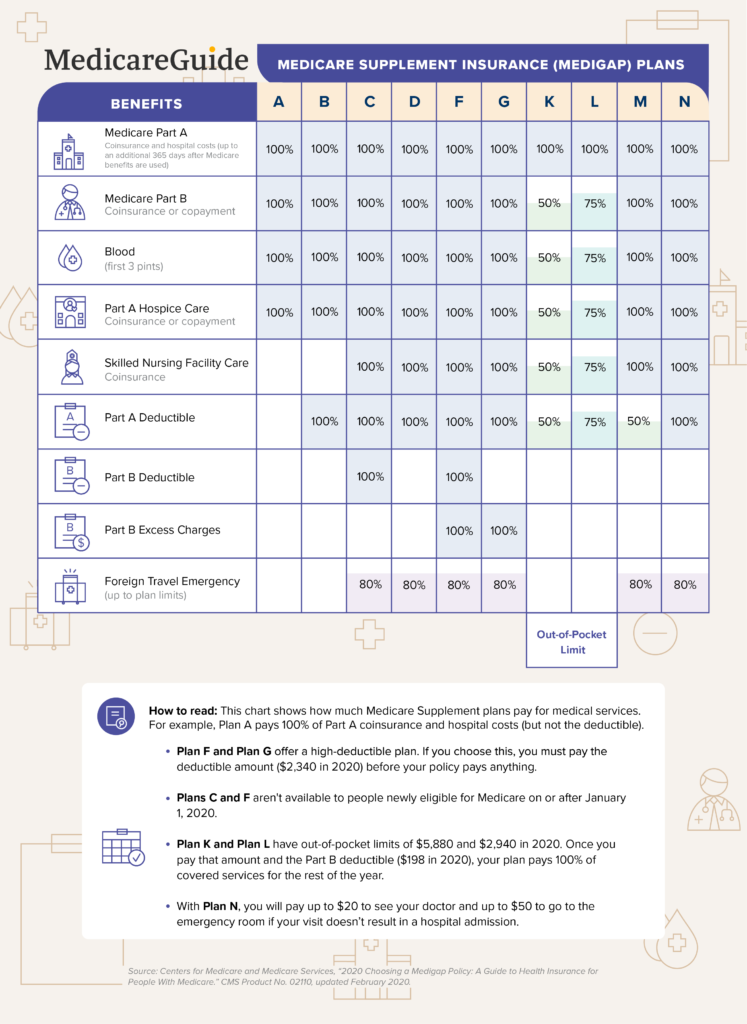What You Need to Know
The best time to enroll in a Medigap policy is during your Medigap Open Enrollment Period.
Plan G and Plan N are the most popular Medicare Supplement plans available to new Medicare beneficiaries.
Plan G premiums for a 65-year-old male or female Montana resident who doesn’t use tobacco range from $108 to $366 per month. Plan N premiums for residents with a similar profile range from $86 to $357 per month.
What Are Medicare Supplement Plans in Montana?
Original Medicare (Medicare Parts A and B) has deductibles, copays and coinsurance, which can leave you with significant out-of-pocket costs. Montana Medicare Supplement plans (also known as Medigap) help to cover those costs. Medicare-approved private insurance companies sell these plans.
All Medicare Supplement plans are standardized and designated by a letter. Plan F with one company has exactly the same benefits as Plan F with another company.1 Only the cost is different.
When Can You Enroll in Medigap?
You can enroll in a Montana Medicare Supplement insurance plan at any time. The best time to enroll in a plan, however, is during your Medigap Open Enrollment Period. This period starts the month you are both age 65 or older and enrolled in Medicare Part B, and it lasts for six months. Insurance companies cannot turn you down for a Medicare Supplement plan or charge you more due to preexisting conditions during this period.
Outside of Medigap Open Enrollment, insurance companies are allowed to deny you coverage or charge you more based on your health history. However, in some circumstances, you may be entitled to a guaranteed issue period, which means insurance companies are required to accept you without charging you more for preexisting conditions.2
You may have guaranteed issue rights for a Medigap policy if:
- You’re in a Medicare Advantage plan and you’ve moved out of the plan’s service area.
- You’re in a Medicare Advantage plan and your plan is leaving Medicare.
- You have Original Medicare plus an employer or union plan and that plan is ending.
- You joined a Medicare Advantage plan when you were first eligible for Medicare Part A and within the first year of joining you decide you want to switch back to Original Medicare.
- You left a Medicare Supplement Plan to join a Medicare Advantage plan for the first time and within the first year of joining, you decide to switch back to your Medicare Supplement plan.
- The company that has your Medigap policy goes bankrupt and you lose your coverage.
- You leave a Medicare Advantage plan or a Medicare Supplement plan because the company misled you.3
Outside Open Enrollment
Except under certain circumstances, insurance companies are allowed to deny you coverage or charge you more for a preexisting condition if you sign up for a Medicare Supplement plan outside of your Medigap Open Enrollment Period.
What Are the Most Popular Medicare Supplement Plans?
| Plan Type | Total Enrolled (Rounded) | Percent of Total Enrolled |
| Plan F | 50,000 | 57% |
| Plan G | 25,000 | 28% |
| Plan N | 6,000 | 7% |
Medicare Supplement Plan F is the most popular Medicare Supplement plan. More than 50% of all Medicare beneficiaries enrolled in a Medicare Supplement plan are in Plan F. It’s popular because it covers Medicare Parts A and B deductibles, coinsurance and copayments. It also covers skilled nursing facility coinsurance, hospice care coinsurance and copayments, and the first three pints of blood.
Starting January 1st, 2020, people who are new to Medicare can no longer buy Plan F. If you started Medicare before January 1st, 2020, you might be able to buy Plan F as long as you either have guaranteed issue rights or you qualify for a policy based on the company’s underwriting guidelines.
Plan G is the second most popular plan, with 28% of people in a Medicare Supplement plan enrolled in Plan G. Plan G covers everything that Plan F does except for the Medicare Part B deductible.
Medicare Supplement Plan N is the third most popular option. Ten percent of enrollees in Medicare Supplement plans have Plan N. It covers everything that Plan F covers except for the Medicare Part B deductible and Part B excess charges. Doctors who don’t accept Medicare assignment can charge up to 15% more than Medicare allows. Plans F and G cover those charges, but Plan N does not.
Plan N also has copayments. There is a copayment of up to $20 for some office visits and a copay of $50 for emergency room visits that don’t result in an inpatient admission.4 5
How Do You Choose a Medicare Supplement Plan?
To choose a Montana Medicare Supplement plan, start by deciding which plans you’re interested in. Next, use the Medicare Plan Finder to find insurance companies approved to sell Medigap policies in Montana. Visit the company websites or call the insurance companies to get the prices for the plans you’re considering.
Keep in mind that plans are standardized, which means that Plan F from one company has exactly the same benefits as Plan F from another company. The prices for plans vary by insurance company, however.
Costs vary because each company uses its own information to determine prices. Companies can use one of three approaches to pricing. The first is community-rated pricing. This means that the company charges the same premium to everyone regardless of age or gender. Premiums may increase due to inflation but not due to age.
The second option is issue-age-rated pricing. This means that the company bases your premium on your age when you buy a Medigap policy. Premiums are lower for people who buy when they’re younger and the cost won’t change as they get older. Premiums may go up because of inflation, however.
The third option is attained-age-rated pricing. With this method, insurance companies base the premium on your current age. This means that your premiums will go up as you get older. Companies that use this pricing method may have the lowest rates when you’re younger, but they may end up being the most expensive as you age. Premiums can also go up because of inflation.6
Why Costs Differ
Costs for the same lettered Medigap plan — say, Plan G — vary according to the method that each insurer uses to price that plan. An insurer can tell you which method it uses.
Do Medicare Supplement Plans Offer Prescription Drug Coverage?
Medigap policies don’t cover prescription drugs. For this coverage, consider buying a Medicare Part D prescription drug plan.7
How Much Do Medigap Policies Cost?
65-Year-Old Woman, No Tobacco Use
| Plan Type | Premium Range |
| Plan F | $120-$386 |
| Plan G | $110-$366 |
| Plan N | $75-$357 |
65-Year-Old Man, No Tobacco Use
| Plan Type | Premium Range |
| Plan F | $ |
| Plan G | $110-$366 |
| Plan N | $75-$357 |
What Companies Sell Medigap in Montana?
What If You Want to Change Your Medigap Policy?
You can change your Medigap policy at any time. Keep in mind that insurance companies can decline your application due to preexisting health conditions if you don’t have guaranteed issue rights.
What Are Alternatives to Medicare Supplement Plans?
Medicare Advantage (MA) plans are an alternative to Medicare Supplement plans. MA plans, offered by Medicare-approved private insurers, are a bundled alternative to Original Medicare and Medigap policies. Many MA plans include Medicare Part D prescription drug benefits as well as other benefits like dental, hearing and vision care.8
What Are Medicare Resources in Montana?
Montana residents can receive free assistance with Medicare-related issues by contacting Montana’s State Health Insurance Assistance Program (SHIP) at 1-800-551-3191.
If you have a complaint about your Medicare insurance, file it with the Commissioner of Securities and Insurance—online or by calling 1-800-332-6148.
If you have limited income and assets, consider applying for Medicaid. Apply online or by calling the Office of Public Assistance at 1-888-706-1535.
Next Steps
To choose a Medicare Supplement plan, review your plan options and contact multiple insurance companies to find the best rate for the plan you want. Keep in mind how companies price their plans, and if you’re not sure, ask. Community-rated plans may cost more initially but may not increase in price as much as attained-age-rated plans.9



